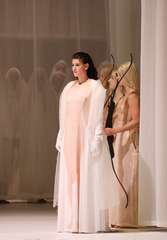|
Back
Magnificent music, dramatic puzzle München
National Theatre
07/09/2017 -
Richard Wagner: Tannhäuser
Klaus Floran Vogt (Tannhäuser), Anja Harteros (Elisabeth), Christian Gerhaher (Wolfram von Eschenbach), Elena Pankratova (Venus), Georg Zeppenfeld (Hermann, Landgrave of Thuringia), Dean Power (Walter von der Wogelweide), Peter Lobert (Biterolf), Ulrich Ress (Heinrich der Schreiber), Ralf Lukas (Reinmar von Zweter), Elsa Benoit (A Young Shepherd)
The Bavarian State Opera Chorus, Sören Eckhoff (chorus master), The Bavarian State Opera Orchestra, Kirill Petrenko (conductor)
Romeo Castellucci (director, set,costume and lighting design), Cindy Van Acker (choreographer), Marco Giusti (video design and lighting assistant)

A. Harteros (© Wilfried Hösl)
The Bavarian State Opera’s 2017 festival, featuring 31 performances of 16 operas (plus recitals, ballet and concerts) within a six-week period, gave just one performance of Tannhäuser, a production that opened with three performances in May. It was no surprise that the theatre was full (all tickets were sold in February). The square in front of the theatre, Max-Joseph-Platz, was also full for the live telecast.
In hiring Romeo Castellucci to direct and design the work, the company was obviously aspiring to an innovative approach (among the plethora of innovative approaches on offer in this era of regie).
It comes as no surprise, then, that right from the start the audience is confronted with images that confound. During the prelude we see bare-breasted female archers - eventually 30 or so of them - shooting arrows at an oculus containing the image of an eye that morphs into an ear and finally a hand holding an apple: the temptation of Eve perhaps? A man in black climbs the arrow-pierced oculus and the opera’s temptess, Venus, appears, emerging nightmarishly from a mound of shiny pink flesh surrounded by pulsating humanoid forms. Tannhäuser has obviously been confronted with a surfeit of fleshly delight, but other imagery is opaque in meaning.
The pilgrims are a faceless mob dressed in black on a dark stage bearing a huge golden boulder. When they return in Act III each is carrying a small golden stone.
For much of the opera we seem to be witnessing a ritual conducted under a mysterious set of rules. The set for Act II consists mostly of swirling draperies lit by varying pastel colours. The visual effect is vapid and this feeling seeps into the performance, especially that of Anja Harteros whose greeting to the hall had a detached quality. A group of dancers is used scenically as they writhe entwined on the floor looking like something primordial striving to be born. And why, while each minstrel sings his bit, does everyone else lie flat on the floor?
While Tannhäuser sings his Rome Narrative in Act III we are given a lesson in Geologic time as we see two corpses laid out on stone slabs (labelled Klaus and Anja) then replaced with increasingly decayed human remains while eons pass. While the chorus exalts the saintly Elisabeth the two leads mix the little mounds of dust that their human remains have become.
Musically the performance was supremely satisfying, thanks especially to Kirill Petrenko’s guidance, with an approach stressing buoyancy and clarity. This did not rule out full orchestral and vocal power coming to the fore, especially for the breathtaking finales of Acts II and III.
The distinctive timbre of Klaus Florian Vogt’s voice has been widely discussed. The first impression is that a Tamino has been hired for a helden role. His voice brings a welcome degree of innocence to the role that is often missing with the usual baritonal (and often leathery) Wagner tenor.
Anja Harteros has a famously beautiful voice and a soulful presence It is a pity her character remained such a cipher. Just what is a performer to do when asked to sit passively (as in Act III) while her character’s corpse (or is it her corpse?) goes through millennia of decay?
In many ways the moral centre of the work is the role of Wolfram to which Christian Gerhaher gave a banked embers quality, with emotions barely suppressed while perfect weight is given to every syllable. A less skilled singer trying this approach could well sound mannered. At the end there was huge applause for everyone, but extra decibels for Gerhaher.
Elena Pankratova as Venus gave further evidence as to why she has become a local favourite, as did Georg Zeppenfeld as the Landgrave. A drawback (among many) of the design was that he and the quartet of minstrels looked anonymous, even from expensive seats.
To sum up: the performance gave pretty much the epitome of delight for the ear, while one’s eye desired more stimulation. One’s mind remained perplexed.
Given the careful preparation (and sizeable budget) devoted to this production, I am surprised it does not appear in the Bavarian State Opera’s upcoming season. Next year’s festival will present six Wagner operas: a Ring cycle, plus Parsifal and Der fliegende Holländer.
Michael Johnson
|